Elementary Formative Assessment Lessons
The Formative Assessment Lesson is designed to be part of an instructional unit. The tasks should be implemented approximately two-thirds of the way through the instructional unit. The results of the tasks should then be used to inform the instruction that will take place for the remainder of the unit.
These lessons are Alpha versions created by Kentucky Department of Education Mathematics Specialists and field tested by Kentucky teachers. If you encounter errors or would like to make suggestions, please use the contact form below.
Click on the picture below to access the lessons from the Kentucky Department of Education website.
Click on the picture below to access the lessons from the Kentucky Department of Education website.
Concept Focused FALs The lessons below have been revised to include a whole class introduction and other edits.
Kindergarten - Decomposing Numbers

This lesson is intended to help you assess how well students are able to decompose numbers less than or equal to 10 into pairs in more than one way. It will help you to identify students who have difficulty anchoring to 5 and 10, identifing different representations of a number sentence, one- to-one correspondence, structuring numbers, and/or addition. This lesson involves mathematical content in the standards from across the grade, with emphasis on Operations and Algebraic Thinking K.OA:Understanding addition as putting together and adding to, and understanding subtraction as taking apart and taking from.This lesson involves a range of Standards for Mathematical Practice, with emphasis on: 2. Reason abstractly and quantitatively. 7. Look for and make use of structure. 8. Look for and express regularity in repeated reasoning.
Kindergarten - Counting Dots (this lesson prints correctly when using the Chrome browser)

This lesson is intended to help you assess how well students are able to count objects up to 10 no matter how they are arranged and also how well they are able to represent their counts with written numerals. It will help you to identify students who have the following difficulties:
Not being able to track where they start/stop counting
Arranging objects to be counted
One-to-one correspondence
Not being able to track where they start/stop counting
Arranging objects to be counted
One-to-one correspondence
NEW- Kindergarten - Greater Than, Less Than, Equal in Range up to 10
Grade 1 - Number Relationships - Equal or Not

This lesson is intended to help you assess how well students are able to use various strategies to add and subtract within 20 using various strategies. It will help you to identify students who have difficulty recognizing equivalent equations and expressions, and or using strategies to determine related equations and expressions. This lesson involves mathematical content in the standards from across the grade, with emphasis on: Operations and Algebraic Thinking 1.OA: Understand and apply properties of operations and the relationship between addition and subtraction, add and subtract within 20, and work with addition and subtraction equations. This lesson involves a range of Standards for Mathematical Practice, with emphasis on: 2. Reason abstractly and quantitatively. 7. Look for and make use of structure. 8. Look for and express regularity in repeated reasoning.
Grade 1 - Place Value Pieces of Hundred Chart

This lesson is intended to help you assess how well students are able to count to count from any number and recognize patterns on the 100 chart that will help them to count on or back. It will also help you to assess how well they write numbers between 1 and 100. It will help you to identify students who have the following difficulties:
Recognizing patterns on the hundred chart.
Counting on or back from a given number
Recognizing patterns on the hundred chart.
Counting on or back from a given number
NEW - Grade 1 Greater Than, Less Than, Equal Range up to 10
Grade 2 - Two digit Computation Mental Math

This lesson is intended to help you assess how well students are able to fluently add and subtract within 100 using strategies based on place value, properties of operations, and/or relationships between adding and subtracting. It will help you to identify students who have difficulty recognizing place value of ones, tens, and hundreds, understanding the commutative and associative properties as they relate to the numbers used in addition and subtraction equations, and applying efficient strategies (especially strategies based on place-value, properties of operations, and the relationship between addition and subtraction) to add and subtract fluently. This lesson involves mathematical content in the standards from across the grades, with emphasis on: Number and Operations in Base Ten 2.NBT: Use place value understanding and properties of operations to add and subtract. This lesson involves a range of Standards for Mathematical Practice, with emphasis on: 2. Reason abstractly and quantitatively. 7. Look for and make use of structure.
Grade 2 - Place Value What's the Value of Place?

This lesson is intended to help you assess how well students are able to recognize the value of the place in a number. It will help you to identify students who have the following difficulties:
Recognizing place value of ones, tens, hundreds.
Use correct mathematical vocabulary to explain place value to a partner.
Make connections of place value to previously taught lessons.
ARROW CARDS - This lesson needs arrow cards for students to manipulate. Click HERE.
Recognizing place value of ones, tens, hundreds.
Use correct mathematical vocabulary to explain place value to a partner.
Make connections of place value to previously taught lessons.
ARROW CARDS - This lesson needs arrow cards for students to manipulate. Click HERE.
NEW Grade 2 Partitioning the Whole Into Equal Shares
Grade 3 - Multiplication

This lesson is intended to evaluate the understanding of your students in multiplication and how well students are able to interpret various representations of multiplication facts. It will help you to identify students who have a lack of conceptual understanding of the properties of numbers, do not see connections from addition to multiplication, or have multiplication facts memorized, but lack conceptual understanding. This lesson involves mathematical content in the standards from across the grades, with emphasis on: Operations and Algebraic Thinking 3.OA: Represent and solve problems involving multiplication and division, multiply and divide within 100. This lesson involves a range of Standards for Mathematical Practices, with emphasis on: 1. Make sense of problems and persevere in solving them. 7. Look for and make use of structure. 8. Look for and express regularity in repeated reasoning
Grade 3 Multiplication Distributive Property

This lesson is intended to help you assess how well students are able to compose and decompose models to show the distributive property, use the distributive property to split a factor into benchmark numbers, use area models, arrays, and equal group models to represent and solve multiplication problems, and justify choices of how to apply the distributive property. ThUnderstand properties of multiplication and the relationship between multiplication and division. This lesson involves mathematical content in the standarads from across the grades with emphasis on: Operations and Algebraic Thinking 3.OA.5: Apply properties of operations as strategies to multiply and divide.2 Examples: If 6 × 4 = 24 is known, then 4 × 6 = 24 is also known. (Commutative property of multiplication.) 3 × 5 × 2 can be found by 3 × 5 = 15, then 15 × 2 = 30, or by 5 × 2 = 10, then 3 × 10 = 30. (Associative property of multiplication.) Knowing that 8 × 5 = 40 and 8 × 2 = 16, one can find 8 × 7 as 8 × (5 + 2) = (8 × 5) + (8 × 2) = 40 + 16 = 56. (Distributive property.) Note: Students need not use formal terms for these properties
Measurement and Data standard 3.MD.7.C: Use tiling to show in a concrete case that the area of a rectangle with whole-number side lengths a and b + c is the sum of a × b and a × c. Use area models to represent the distributive property in mathematical reasoning. This lesson involves a range of Standards for Mathematical Practice (MP), with emphasis on:
MP.1. Make sense of problems and persevere in solving them.
MP.3. Construct viable arguments and critique the reasoning of others.
MP.4. Model with mathematics.
MP.7. Look for and make use of structure.
Measurement and Data standard 3.MD.7.C: Use tiling to show in a concrete case that the area of a rectangle with whole-number side lengths a and b + c is the sum of a × b and a × c. Use area models to represent the distributive property in mathematical reasoning. This lesson involves a range of Standards for Mathematical Practice (MP), with emphasis on:
MP.1. Make sense of problems and persevere in solving them.
MP.3. Construct viable arguments and critique the reasoning of others.
MP.4. Model with mathematics.
MP.7. Look for and make use of structure.
Grade 3 - Fractions on a Number Line

This lesson is intended to help you assess how well students are able to understand a fraction as the quantity formed by 1 part when a whole is partitioned into equal parts, represent a fraction on a number line diagram, understand two fractions are equivalent (equal) if they are the same point on a number line, and solve fraction word problems using the number line to represent solutions. This lesson asks students to select and apply Standards for Mathematical Content from across the grades, with the emphasis on: Number and Operations – Fractions 3.NF (Grade 3 expectations in this domain are limited to fractions with denominators 2, 3, 4, 6, and 8.)Developing understanding of fractions as numbers. 3.NF.1 Understand a fraction 1/b as the quantity formed by 1 part when a whole is partitioned
into b equal parts: understand a fraction a/b as the quantity formed by a parts of 1/b. 3.NF.2a.b. Understand a fraction as a number on the number line; represent fractions on a number line diagram. 3. NF.3 Explain equivalence of fractions in special cases, and compare fractions by reasoning about their size.
into b equal parts: understand a fraction a/b as the quantity formed by a parts of 1/b. 3.NF.2a.b. Understand a fraction as a number on the number line; represent fractions on a number line diagram. 3. NF.3 Explain equivalence of fractions in special cases, and compare fractions by reasoning about their size.
Grade 3 - Attributes of Shapes
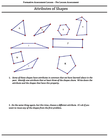
This lesson is intended to help you assess how well students are able to:
Identify defining attributes of shapes, Think abstractly and concretely, Defend mathematical decisions. In this unit, students use the attributes of shapes to view shapes as members of both specific sub-categories and larger, more general, categories. This lesson involves a range of mathematical practices from the standards, with emphasis on: Reason abstractly and quantitatively, Construct viable arguments and critique the reasoning of others, Attend to precision, Look for and make use of structure. This lesson asks students to apply mathematical content from: 3.G – Reason with shapes and their attributes
Identify defining attributes of shapes, Think abstractly and concretely, Defend mathematical decisions. In this unit, students use the attributes of shapes to view shapes as members of both specific sub-categories and larger, more general, categories. This lesson involves a range of mathematical practices from the standards, with emphasis on: Reason abstractly and quantitatively, Construct viable arguments and critique the reasoning of others, Attend to precision, Look for and make use of structure. This lesson asks students to apply mathematical content from: 3.G – Reason with shapes and their attributes
Grade 4 - Multi-digit Multiplication Strategies
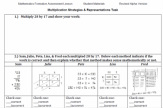
This concept-based lesson is intended to help you assess how well students are able to use a variety of strategies to multiply. In particular, this unit aims to identify and help students who have difficulties with representing multiplication in multiple ways. Common Core State Standards: This lesson involves a range of mathematical practices from the standards, with emphasis on: 2. Reason abstractly and quantitatively, 7. Look for and make use of structure, 8. Look for and make use of repeated reasoning. This lesson asks students to select and apply mathematical content from across the grades, including the content standards: Number and Operations in Base Ten: 4-NBT: Use place value understanding and properties of operations to perform multi-digit arithmetic and
Grade 4 - Number Puzzles
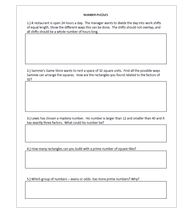
This lesson is intended to help you assess how well students are able to use "clues" about numbers including: factors, multiples, prime, composite, square, even, odd, etc. In particular, this unit aims to identify and help students who have difficulties with: understanding the difference between primes and
composites. understanding the difference between factors and multiples. This lesson involves mathematical content in the standards from across the grade, with emphasis on: Operations and Algebraic Thinking 4.OA Gain familiarity with factors and multiples. This lesson involves a range of mathematical practices from the standards, with emphasis on: 1. Make sense of problems and persevere in solving them. 2. Reason abstractly and quantitatively. 6. Attend to recision. 7. Look for and make use of structure.
composites. understanding the difference between factors and multiples. This lesson involves mathematical content in the standards from across the grade, with emphasis on: Operations and Algebraic Thinking 4.OA Gain familiarity with factors and multiples. This lesson involves a range of mathematical practices from the standards, with emphasis on: 1. Make sense of problems and persevere in solving them. 2. Reason abstractly and quantitatively. 6. Attend to recision. 7. Look for and make use of structure.
Grade 4 - Relating Fraction Equiviliencies to Decimal Fractions

This lesson is intended to help you assess how well students are able identify equivalent decimal fractions. Students will: Recognize and generate equivalent fractions. Use Equivalent fractions to add and subtract fractions with like denominators. Use decimal notation for fractions with denominators 10 and 100. Use words to indicate the value of the decimal. Use decimal fractions and locating them on the number line. Use area models to represent equivalent fractions and decimals. This lesson involves mathematical content in the standards from across the grade, with emphasis on: 4.NF Extend understanding of fraction equivalence and ordering. (Note: Ordering of fractions is not addressed in this lesson.)Build fractions from unit fractions by applying and extending previous understandings of operations on whole numbers. Understand decimal notation for fractions, and compare decimal fractions. This lesson involves a range of Standards for Mathematical Practice
with emphasis on: Make sense of problems and persevere in solving them.
Construct viable arguments and critique the reasoning of others. Look for and
make use of structure.
with emphasis on: Make sense of problems and persevere in solving them.
Construct viable arguments and critique the reasoning of others. Look for and
make use of structure.
NEW Grade 4 Two Dimensional Shapes, Angles, and Symmetry

This lesson is intended to help you assess how well students are able to identify and sort quadrilaterals based on their properties and attributes, identify and classify angles and identify the angles in two-dimensional figures, identify and sort two-dimensional figures based on the absence or presence of characteristics such as parallel and perpendicular lines and angles of a specified size (acute, obtuse, right), identify right triangles as a category for classification, identify lines of symmetry and classify symmetrical figures, and draw lines of symmetry. This lesson involves mathematical content in the standards from across the grade, with emphasis on:
4.G.2 Classify two-dimensional figures based on the presence or absence of parallel or perpendicular lines, or the presence or absence of angles of a specified size. Recognize right triangles as a category, and identify right triangles. 4.G.3 Recognize a line of symmetry for a two-dimensional figure as a line across the figure such that the figure can be folded along the line into matching parts. Identify line-symmetric figures and draw lines of symmetry.
This lesson involves a range of Standards for Mathematical Practice, with emphasis on:
MP3: Construct viable arguments and critique the reasoning of others.
MP6: Attend to precision.
MP7: Look for and make use of structure.
MP8: Look for and express regularity in repeated reasoning.
4.G.2 Classify two-dimensional figures based on the presence or absence of parallel or perpendicular lines, or the presence or absence of angles of a specified size. Recognize right triangles as a category, and identify right triangles. 4.G.3 Recognize a line of symmetry for a two-dimensional figure as a line across the figure such that the figure can be folded along the line into matching parts. Identify line-symmetric figures and draw lines of symmetry.
This lesson involves a range of Standards for Mathematical Practice, with emphasis on:
MP3: Construct viable arguments and critique the reasoning of others.
MP6: Attend to precision.
MP7: Look for and make use of structure.
MP8: Look for and express regularity in repeated reasoning.
Grade 5 - Pizza With Friends

This lesson is intended to help you assess how well students are able to model addition and subtraction of fractions. In particular, this unit aims to identify and help students who have difficulties with: Using equivalent fractions to add and subtract fractions, Using benchmark fractions and number sense of fractions to estimate mentally and assess the reasonableness of answers, and Solving word problems involving the addition and subtraction of fractions. This lesson asks students to select and apply mathematical content from across the grades,
including the CCSS Number and Operations 5.NF Use equivalent fractions as a strategy to add and subtract fractions. This lesson involves a range of Standards for Mathematical Practice, with emphasis on: 1. Make sense of problems and persevere in solving them. 3. Construct viable arguments and critique the reasoning of others.
4. Model with mathematics. 7. Look for and make use of structure
including the CCSS Number and Operations 5.NF Use equivalent fractions as a strategy to add and subtract fractions. This lesson involves a range of Standards for Mathematical Practice, with emphasis on: 1. Make sense of problems and persevere in solving them. 3. Construct viable arguments and critique the reasoning of others.
4. Model with mathematics. 7. Look for and make use of structure
_Grade 5 - Division and Interpreting Remainders
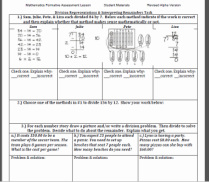
This concept-based lesson is intended to help you assess how well students are able to use a variety of strategies to multiply. In particular, this unit aims to identify and help students who have difficulties with the traditional division algorithm,representing division in multiple ways, and interpreting remainders. This lesson involves a range of mathematical practices from the standards, with emphasis on: Reason abstractly and quantitatively, Look for and make use of structure, Look for and make use of repeated reasoning. This lesson asks students to select and apply mathematical content from across the grades, including the CCSS Number and Operations in Base Ten: 5-NBT: Perform operations with multi-digit whole numbers and 6-NS: Compute fluently with multi-digit numbers and find common factors and multiples.
Grade 5 Multiplication and Division with Decimals
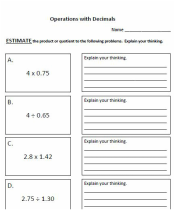
This concept-based lesson is intended to help you assess how well students understand the result of multiplying and dividing less than and greater than one and what strategies they use to perform these operations. It will help you to identify students who have difficulty with conceptual understanding of the properties of numbers, not seeing the relationship between multiplication and division, and applying efficient strategies to multiply and divide with decimals to hundredths.
Grade 5 Volume
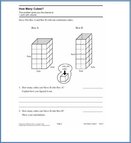
This lesson is intended to help you assess how well students are able to model three dimensional figures and find their volume. In particular, this unit aims to identify and help students who have difficulties with: Recognizing volume as an attribute of three-dimensional space. Measuring volume by finding the total number of same-size units of volume required to fill the space without gaps or overlaps. Measuring necessary attributes of shapes, in particular the base area, in order to determine volumes to solve real world and mathematical problems.
Kentucky Academic Standards: This lesson involves mathematical content in the standards from across the grade, with emphasis on: Measurement and Data 5.MD;
Geometric measurement: understand concepts of volume and relate volume to multiplication and to addition. This lesson involves a range of Standards for Mathematical Practice with emphasis on: 1. Make sense of problems and persevere in solving them. 4. Model with mathematics. 7. Look for and make use of structure.
Kentucky Academic Standards: This lesson involves mathematical content in the standards from across the grade, with emphasis on: Measurement and Data 5.MD;
Geometric measurement: understand concepts of volume and relate volume to multiplication and to addition. This lesson involves a range of Standards for Mathematical Practice with emphasis on: 1. Make sense of problems and persevere in solving them. 4. Model with mathematics. 7. Look for and make use of structure.
NEW - Grade 5 Metric Comparisons and Conversions
Problem Solving FAL's
Grades 1-5 Snail in A Well

Students may enter this problem solving task in a multiple of ways. There is student work included for students to anayze as part of the learning process.
Grade K - 3 - Caterpillars and Leaves

This lesson unit is intended to help you assess how well students are able to use addition and subtraction in a problem solving situation. In particular, this lesson aims to identify and help students who have difficulties with:
Choosing an appropriate, systematic way to collect and organize data.
Examining the data and looking for patterns
Describing and explaining findings clearly and effectively.
Choosing an appropriate, systematic way to collect and organize data.
Examining the data and looking for patterns
Describing and explaining findings clearly and effectively.
Grade 4 - Farmer Fred's Fields (from Pennsylvania)
|
Grade 4-High School - Beads Under a Blanket

This problem solving lesson is intended to help you assess how well students are able to identify patterns (both linear and exponential) in a realistic context: the number of beads of different colors that are hidden behind the cloud. In particular, this problem solving lesson aims to identify and help students who have difficulties with: Choosing an appropriate, systematic way to collect and organize data. Examining the data and looking for patterns. Describing and explaining findings clearly and effectively.
Grade 4-6 Fractions: Where are the Cookies?

This lesson is intended to help you assess how well students are able to use fractions in a problem solving context. In particular this lesson aims to identify and help students with difficulties:
Conceptualizing fractional parts of different wholes
Choosing an appropriate, systematic way to collect and organize to display multiple step tasks
Conceptualizing fractional comparisons and fractional parts of other fractions
Kentucky Academic Standards
This lesson involves a range of mathematical practices, with emphasis on:
1. Make sense of problems and persevere in solving them.
4. Model with mathematics.
7. Look for and make use of structure.
This lesson involves mathematical content in the standards from across the grades, with emphasis
on: 4.NF Build fractions from unit fractions by applying and extending previous
understandings of operations on whole numbers. 5.NF Apply and extend previous understandings of multiplication and division to multiply and divide fractions. 6.NS Apply and extend previous understandings of multiplication and division.
Conceptualizing fractional parts of different wholes
Choosing an appropriate, systematic way to collect and organize to display multiple step tasks
Conceptualizing fractional comparisons and fractional parts of other fractions
Kentucky Academic Standards
This lesson involves a range of mathematical practices, with emphasis on:
1. Make sense of problems and persevere in solving them.
4. Model with mathematics.
7. Look for and make use of structure.
This lesson involves mathematical content in the standards from across the grades, with emphasis
on: 4.NF Build fractions from unit fractions by applying and extending previous
understandings of operations on whole numbers. 5.NF Apply and extend previous understandings of multiplication and division to multiply and divide fractions. 6.NS Apply and extend previous understandings of multiplication and division.
This is a list of Formataive Asessment Lessons and descriptions K-12

Click here for a complete list of Formative Assessment Lessons and descriptions K-12.


